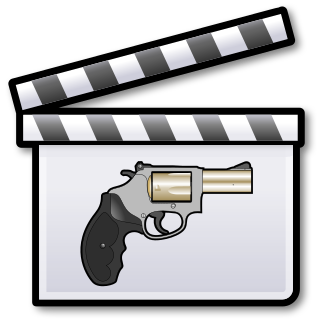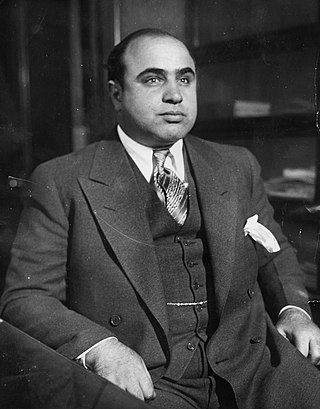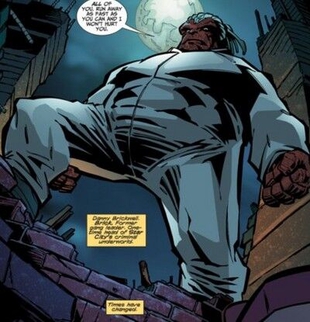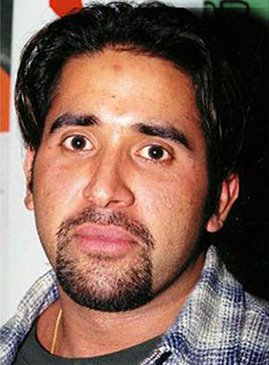A gang is a group or society of associates, friends, or members of a family with a defined leadership and internal organization that identifies with or claims control over territory in a community and engages, either individually or collectively, in illegal, and possibly violent, behavior, with such behavior often constituting a form of organized crime.
A gangster is a criminal who is a member of a gang. Most gangs are considered to be part of organized crime. Gangsters are also called mobsters, a term derived from mob and the suffix -ster. Gangs provide a level of organization and resources that support much larger and more complex criminal transactions than an individual criminal could achieve. Gangsters have been active for many years in countries around the world. Gangsters are the subject of many novels, films, television series, and video games.

Crime films, in the broadest sense, is a film genre inspired by and analogous to the crime fiction literary genre. Films of this genre generally involve various aspects of crime and its detection. Stylistically, the genre may overlap and combine with many other genres, such as drama or gangster film, but also include comedy, and, in turn, is divided into many sub-genres, such as mystery, suspense or noir.

Hammerhead is a supervillain appearing in American comic books published by Marvel Comics. The character is primarily depicted as an adversary of the superhero Spider-Man. He is a temperamental mobster who often dresses and acts in the 1920s style, and a prominent member of the Maggia, a fictional organized crime syndicate. Following an accident, he had most of his skull replaced with an inflexible steel alloy by Jonas Harrow, giving his head a flattened shape and near-indestructibility, hence his nickname. The Hammerhead crime family, of which he is the second and current head, is named after the character.

Trương Văn Cam, known by the sobriquet Năm Cam was a notorious Vietnamese mobster who is often called the "Godfather" of Vietnam. Known for building and running a criminal enterprise revolving around gambling dens, hotels, racketeering, extortion, loan sharking and restaurants that fronted for brothels, during his heyday, Năm Cam was considered one of the most powerful mob bosses in Vietnam, and was said to have attained influence that even extended into the ranks of Vietnam's Communist Party which he used to his advantage by bribing law enforcement and government officials to protect his lucrative enterprise and cover up his murders of other criminal rivals in Saigon that challenged his reign. In fact, his connection and ties with the Vietnam's Communist Party was so tight that during his trial, 153 other people that were tried with him were high ranking officers of the Communist Party.
The United Bamboo Gang, also known as the Bamboo Union, is the largest of Taiwan's three main criminal Triads. They are reported to have roughly 20,000 members. The membership consists largely of waishengren and has had historic ties to the Kuomintang; they are said to be motivated as much by political ideology as by profit. They are known to simply call themselves "businessmen", but in reality, are also involved in organized killings and drug trafficking. The gang gained global notoriety when it became directly involved in politics in the early 1980s.

A crime boss, also known as a crime lord, mafia don, gang lord, gang boss, mob boss, kingpin, godfather, crime mentor or criminal mastermind, is the leader of a criminal organization.
The Irish Mob is a usually crime family–based ethnic collective of organized crime syndicates composed of primarily ethnic Irish members which operate primarily in Ireland, the United States, the United Kingdom, Canada and Australia, and have been in existence since the early 19th century. Originating in Irish-American street gangs – famously first depicted in Herbert Asbury's 1927 book, The Gangs of New York – the Irish Mob has appeared in most major U.S. and Canadian cities, especially in the Northeast and the urban industrial Midwest, including Boston, New York City, Philadelphia, Pittsburgh, Baltimore, Cleveland, and Chicago.
Organised crime in India refers to organised crime elements originating in India and active in many parts of the world. The purpose of organised crime in India, as elsewhere in the world, is monetary gain. Its virulent form in modern times is due to several socio-economic and political factors and advances in science and technology. There is no firm data to indicate the number of organised criminal gangs operating in the country, their membership, their modus operandi, and the areas of their operations. Their structure and leadership patterns may not strictly fall in line with the classical Italian mafia.

Brick is a DC Comics supervillain and enemy of Green Arrow. Although his origin has not been revealed, Brick is a metahuman with a reddish, stony skin that granted him immense strength and durability. His success as an underworld kingpin was due to his brilliant criminal mind rather than these superhuman powers.

Jewish-American organized crime initially emerged within the American Jewish community during the late 19th and early 20th centuries. In media and popular culture, it has variously been referred to as the Jewish Mob, the Jewish Mafia, the Kosher Mob, the Kosher Mafia, the Yiddish Connection, and Kosher Nostra or Undzer Shtik. The last two of these terms are direct references to the Italian cosa nostra; the former is a play on the word for kosher, referring to Jewish dietary laws, while the latter is a calque of the Italian phrase 'cosa nostra' into Yiddish, which was at the time the predominant language of the Jewish diaspora in the United States.

The Atlantic City Conference held between 13–16 May 1929 was a historic summit of leaders of organized crime in the United States. It is considered by most crime historians to be the earliest organized crime summit held in the US. The conference had a major impact on the future direction of the criminal underworld and it held more importance and significance than the Havana Conference of 1946 and the Apalachin meeting of 1957. It also represented the first concrete move toward a National Crime Syndicate.

Frank McErlane (1894–1932) was a Prohibition-era Irish-American organized crime figure. He led the Saltis-McErlane Gang, allied with Rusyn American gangster Joseph Saltis and the Johnny Torrio-Al Capone led Chicago Outfit, against rival Irish-American bootleggers, the Southside O'Donnell Gang. He is credited with introducing the Thompson submachine gun to Chicago's underworld. The Illinois Crime Survey called him "the most brutal gunman who ever pulled a trigger in Chicago."

Ranj Dhaliwal is a Canadian author.

Daaku is a 2006 Canadian crime fiction novel by Ranj Dhaliwal.
Indo-Canadian organized crime is made up predominantly of young adults and teenagers of Indian ethnic, cultural and linguistic background. Collectively, these groups are among the top 5 major homegrown organized crime hierarchy across the nation in Canada coming in 3rd place, after the Asian Triads and White biker gangs. The 2004 RCMP British Columbia Annual Police Report ranked them third in terms of organization and sophistication in British Columbia, ranked behind outlaw motorcycle clubs and aforementioned Chinese criminal organizations such as the Triads drug clans.
Vũ Thị Hoàng Dung was a Vietnamese female gangster. Born and raised in Haiphong, Dung Hà was a high-ranking criminal member in the city, and during her peak in the 1990s, she and Năm Cam were considered as the two great mafia bosses of the Vietnamese underworld. On October 2, 2000, Dung Hà was assassinated under orders from Năm Cam, who had previously been in a feud with Dung Hà in Saigon. This event eventually led to the destruction of Năm Cam and his gang by the police and authorities, as Cam was later sentenced to death for ordering her murder.

A gangster film or gangster movie is a film belonging to a genre that focuses on gangs and organized crime. It is a subgenre of crime film, that may involve large criminal organizations, or small gangs formed to perform a certain illegal act. The genre is differentiated from Westerns and the gangs of that genre.

Ranjit "Ranj" Singh Cheema was a Vancouver-based Indo-Canadian gangster, drug trader and longtime under-world rival of notorious gangster and former Cheema disciple, Bindy Johal. He was involved in organized crime for over two-decades in Vancouver and also in cocaine trafficking.

Xã hội đen, or hắc xã hội, is a Vietnamese term used to describe criminal forces, whose goal is to make money from illegal and overall immoral activities. The term is believed to have become widly used thanks to Hongkong's TV series and movies about the Chinese secret society Heishehui.













